In Japan, there are many different good luck symbols. Lots of these originated in Japanese folklore but they’re all still considered to be lucky today.
All cultures view luck differently and all countries have different symbolic vocabularies. Good luck symbols exist in most countries.
They’re often used to ward off bad luck, grant wishes, or convey good fortune.
Good luck symbols appear across many aspects of a culture, including in artistic works such as carvings and paintings.
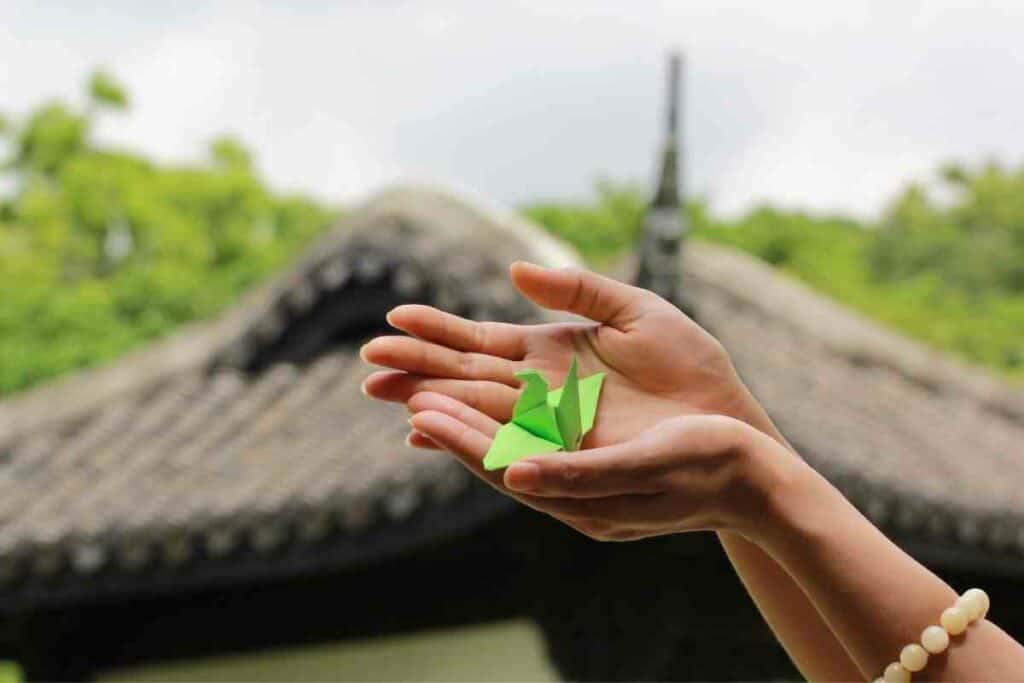
They’re often found on gifts too like charms.
There is perhaps only one culture that doesn’t believe in the concept of luck at all and that’s Islamic culture.
Most people would all welcome a little extra luck now and again and in Japan, there are lots of Japanese good luck symbols to get hold of in the hope of having a little more good fortune.
In This Article – We’ll look at some of the most common Japanese good luck symbols, and maybe next time you want to wish someone ganbatte (good luck), you can do it with one of these symbols.
Table of Contents
The beckoning cat, Maneki Neko
Perhaps the most well-known of Japanese good luck symbols is the beckoning cat, Maneki Neko.
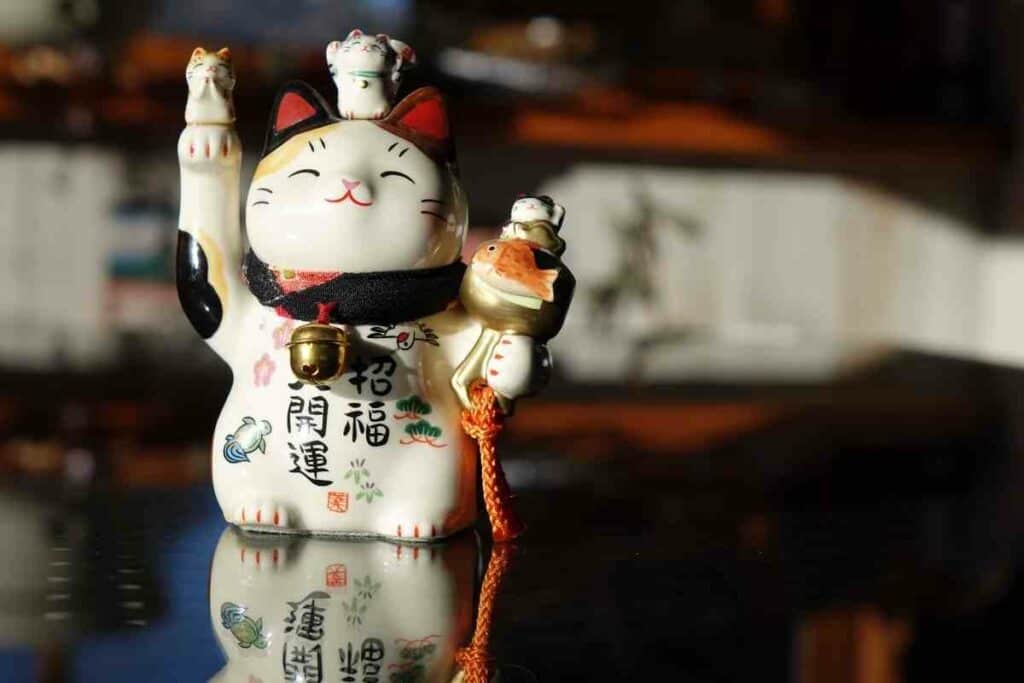
This figurine is a common sight in Japan, and it’s believed to give its owner good luck.
Nowadays – These figurines are plastic or ceramic. They depict a cat, which was traditionally a Japanese bobtail, with its paw raised.
You’ll see these figures all over Japan in restaurants, shops, casinos, bars, hotels, laundromats, and dry cleaners to name a few.
Some Japanese maneki-neko have a mechanical paw that moves in a waving motion.
There are lots of different styles and colors of maneki-neko and some have more detail than others.
You’ll commonly see them in red, white, gold, and black. They’re also popular symbols on air fresheners, piggy banks, and keychains.
The Swastika – a symbol of good luck in Japan
Most Westerners recognize the swastika as a representation of the Nazi party of the 1920s, 30s, and 40s.
For most people in Europe during these decades and beyond, the symbol represented the worst of humanity.
However, the swastika has been around for much longer than the last century.
It began in India as a symbol of wellbeing and goodness. It was adapted by Buddhism to symbolize eternity and this meaning traveled through to Japan.
In Japan, you’ll see maps adorned with swastikas. This symbol represents the location of a Buddhist temple, and the Japanese word is manji.
The manji, however, is a mirrored swastika. It is a symbol of good luck and prosperity. You’ll come across swastikas in all sorts of places in Japan.
Shichifukujin
Shichifukujin stands for the Seven Gods of Fortune or the Seven Lucky Gods and come from Japanese mythology.
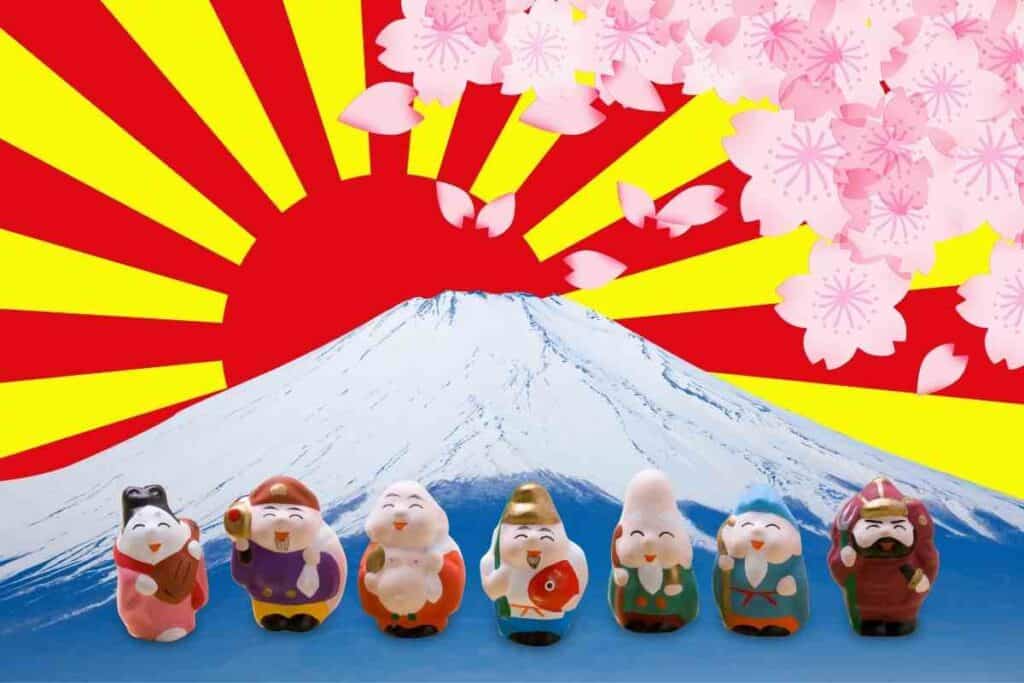
The gods are Japanese good luck symbols with each one having a traditional association.
You’ll see them in:
- paintings
- wall hangings
- stone statues
- carvings, and other art
One of the most familiar is the Hotei or Laughing Buddha. This bald and obese man is usually laughing or smiling.
He has a sack on his shoulder in which he carries wealth, good luck, and happiness. It’s believed that he cheers people up when they’re having a bad day.
Apparently – If you rub his belly, you will get good luck. He also goes by the names Happy Man, Pu-tai, and Maitreya.
Omamori – lucky talismans
These items are considered to be lucky charms.
You can buy them from Japanese shrines. They’re usually wrapped in a brocade bag and if you peek inside, it’s considered to be bad luck.
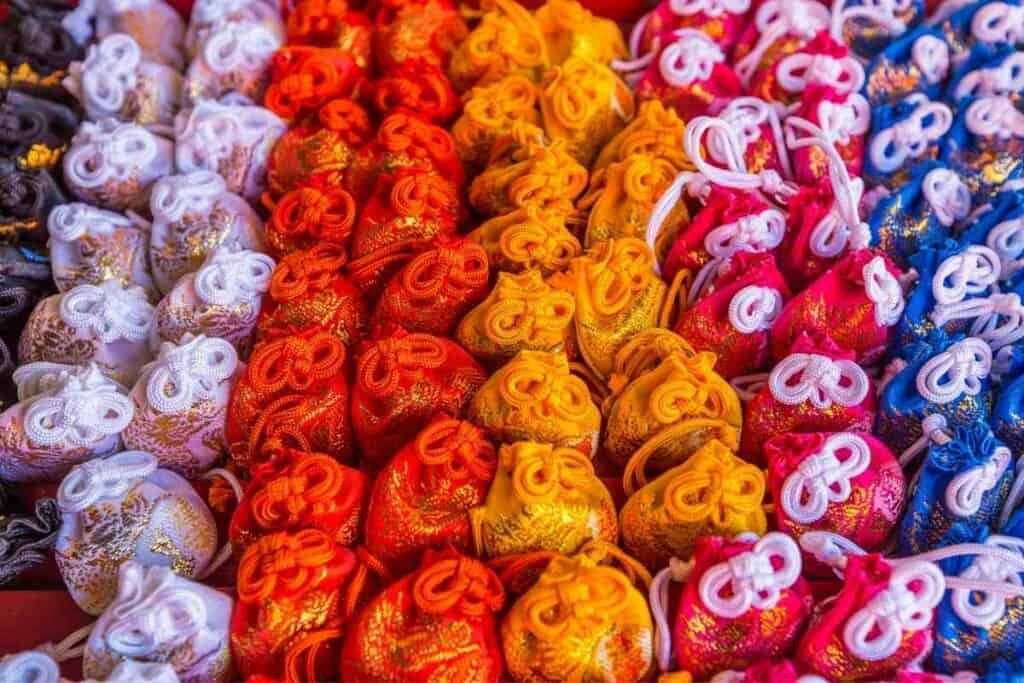
There are protective amulets that are generic while other omamori have a specific purpose. You will find ones for good fortune in love or business, good grades, and healthy pregnancy.
Omammori are usually brightly colored and have the name of the shrine or temple they came from on one side and what they protect on the other.
Inside, they contain a piece of paper with a prayer and a god’s name to protect you. But once it has been opened, you are no longer protected and need to buy another.
The belief is that the talismans don’t expire if their insides are never exposed to air. However, most Japanese people will replace them each year.
They return their old ones to the shrine where they’re destroyed. Some people choose to keep their old ones for the memories, however.
Omamori are so popular because they’re inexpensive. You can also see how they’ve adapted and evolved with the times.
For Example: You now see ones for road safety, which wouldn’t have been needed a century ago. In a similar way, you can also find omamori with characters on like Hello Kitty and Mickey Mouse.
Daruma – Bodhidharma Dolls
Another of the most popular Japanese good luck symbols is the daruma doll.
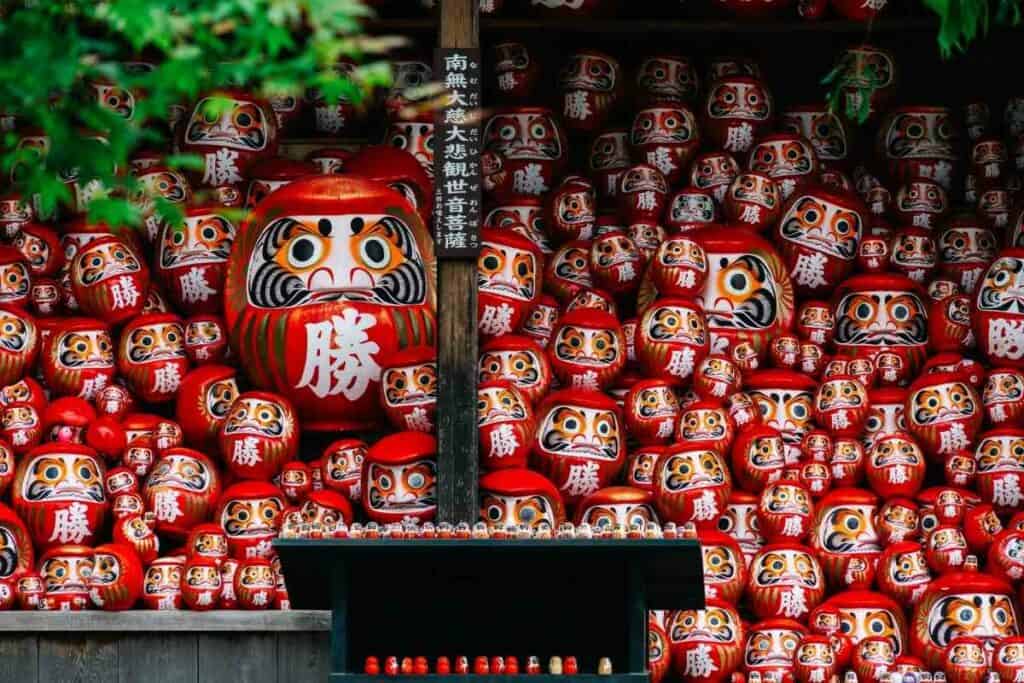
These are little figurines that are modeled on Bodhidharma, who was the founding monk of Zen Buddhism.
These figurines are usually hollow and rounded and painted red. Artists are free to design them however they wish, though.
This good luck symbol is made for wishes. When you buy a daruma doll, its eyes will be empty.
The owner will paint in an eye and make their wish then when the wish comes true, they complete the second eye.
Omikuji – paper fortunes
Omikuji are little paper strips containing a fortune. Lots of shrines in Japan offer omikuji to people visiting.
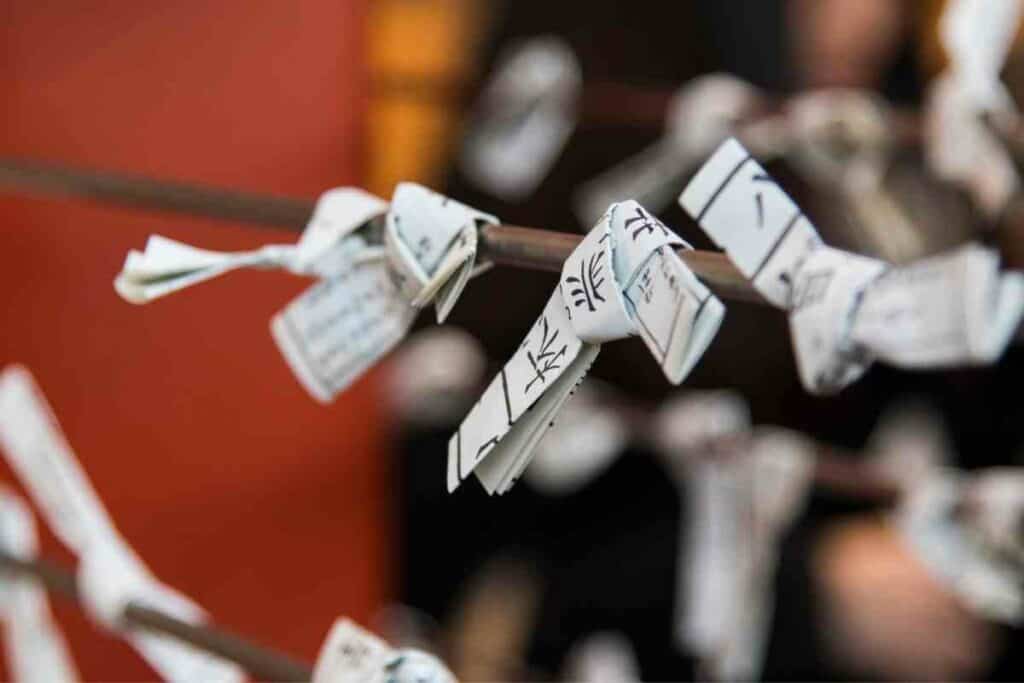
The omikuji doesn’t just say that you’ll have good luck or bad luck, it describes a person’s fortune in detail and often features things like luck in romantic relationships, health, and money.
What to Do? If the fortune is a good one, you keep the piece of paper to keep the good fortune. If it is bad, you tie your strip on a string or wire at the shrine and leave your bad fortune behind.
Ema – wishing plaques
Ema are a custom of Shintoism and you’ll find them throughout Japanese shrines.
It’s also possible to find them in the temple since Shinto and Buddhism have mixed up a lot.
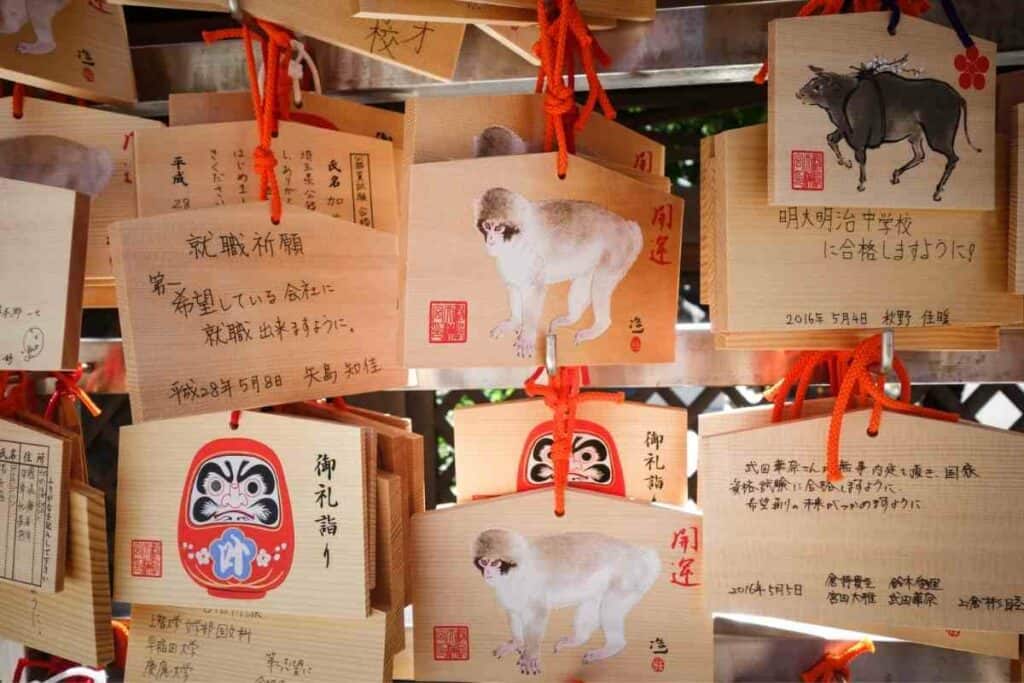
These wooden plaques are decorations that people write down their prayers or wishes on as a declaration.
People then hang them up within the grounds of the shrine. Eventually, these plaques are burned in a ceremonial fire that takes place at the shrine.
Koinobori – carp streamers
Koinobori or carp streamers are a traditional Children’s Day decoration.
Children’s Day of Kodomo no Hi, is a national holiday that is celebrated each year on the 5th of May.
This celebration has been a national holiday since 1948 but it has been celebrated since ancient times.
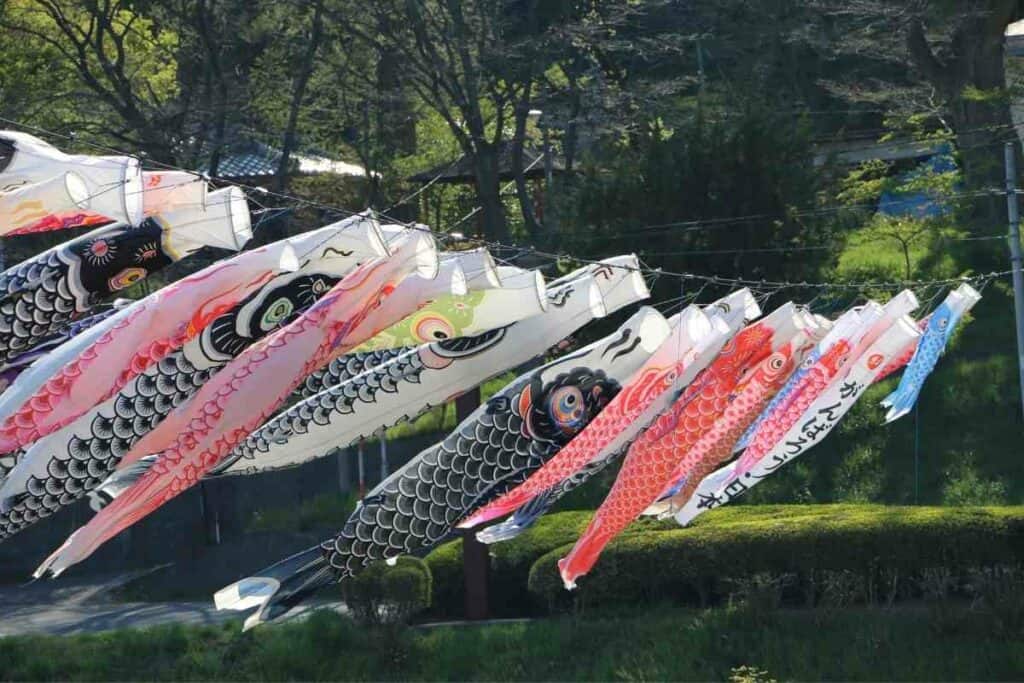
Koinobori are windsocks that are used to wish for advancement and success for children. Koinobori will be visible on displays throughout Japan between the end of April and the beginning of May.
They’re multicolored and will often be floating around between buildings and other public places.
These Japanese good luck symbols create really stunning imagery.
Osechi Ryori – New Year Cooking
Another of Japan’s good luck symbols is its traditional New Year’s foods osechi ryori.
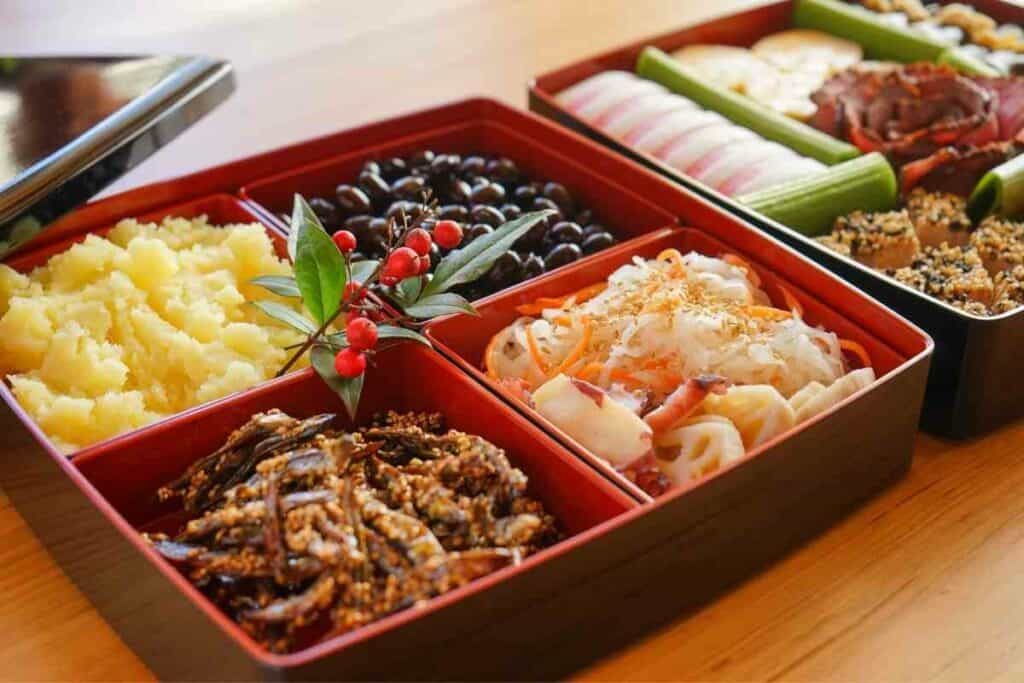
These foods are supposed to bring people good luck for the new year. There are specific foods for different fortunes.
Marinated herring roe, for example, is for people wishing for children. When people are wishing for good health, they will eat soybeans.
Read later – 10 Best New Year Celebrations In Japan
Senbazuru – 1,000 paper cranes
In Japanese, senbazuru means 1,000 cranes.
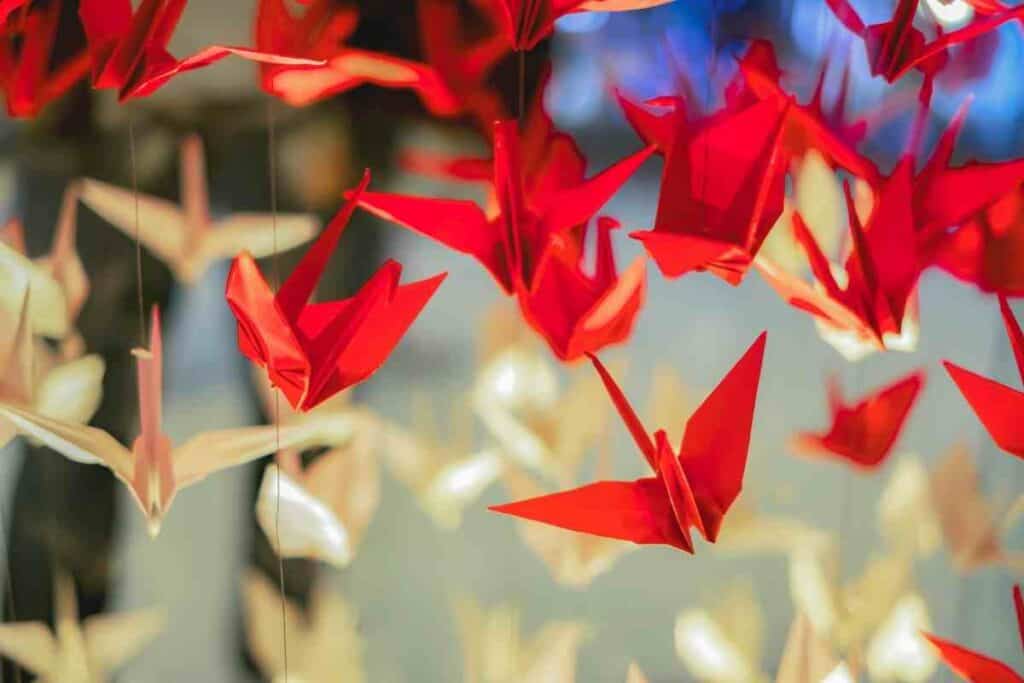
This is a group of origami cranes that consists of 40 cranes on 25 strings.
According to Japanese Legend – Anyone who folds 1,000 origami cranes is granted a wish by the gods. Some people believe you are granted eternal good luck or happiness instead of a wish.
In Japan, the crane is seen as a mystical and holy creature who is said to live 1,000 years, which is why there are 1,000 cranes – one for each year.
Some stories state that a person must complete their 1,000 cranes within a year so that they can make their wish.
Kit Kat – lucky chocolate
At the beginning of the 1970s, Kit Kat arrived in Japan.

This chocolate bar ended up being a huge success. This is because its name was very similar to the Japanese phrase kitto katsu, which means “surely win”.
Because of this, this chocolate bar became popular to give to students during their exams. To this day, many people associate with good fortune.
Final Thoughts
It’s clear to see that there are many Japanese good luck symbols and all of them have an interesting history.
What’s great for visitors is that lots of these can be purchased to bring that Japanese good fortune home with you.
It would be very hard to resist looking inside an omamori though, and a long way to travel back for a replacement if you did peek inside!
Read Next
- 12 Things Tourists Should NEVER Say in Japan
- Kissing Robot: Exploring the Popularity of the Chinese Kissing App
- Unlocking the Secret Dating Rituals Only Locals Know in Japan
- Samurai Armor: Ancient Protection for Japan’s Elite Warriors
- 10 Amazing Facts About Schools in Japan: Unique Traditions and Educational Practices
- Where can you see snow monkeys in Japan: Best locations and viewing tips









